Justice 456 Essay: Policing and Islam in Australia's Society
VerifiedAdded on 2022/10/17
|15
|4201
|18
Essay
AI Summary
This essay examines the evolving relationship between policing and the Muslim community in Australia. Part A analyzes the growth and changes in the Muslim population over the last decade, supported by statistical data from census reports and immigration patterns, noting the diverse ethnic and sectarian groups within the community and their geographical distribution across Australian cities. The analysis also highlights the impact of these demographic shifts on Australian society and identity. Part B projects the potential impacts of these changes on law enforcement agencies and their strategies, particularly focusing on the influence of policies related to extremism, radicalization, and terrorism, and the challenges of balancing security concerns with community relations and the protection of civil liberties. The essay considers the evolution of law enforcement strategies, including policy adjustments and the use of technology, in response to the changing dynamics of the Muslim community and broader societal concerns.
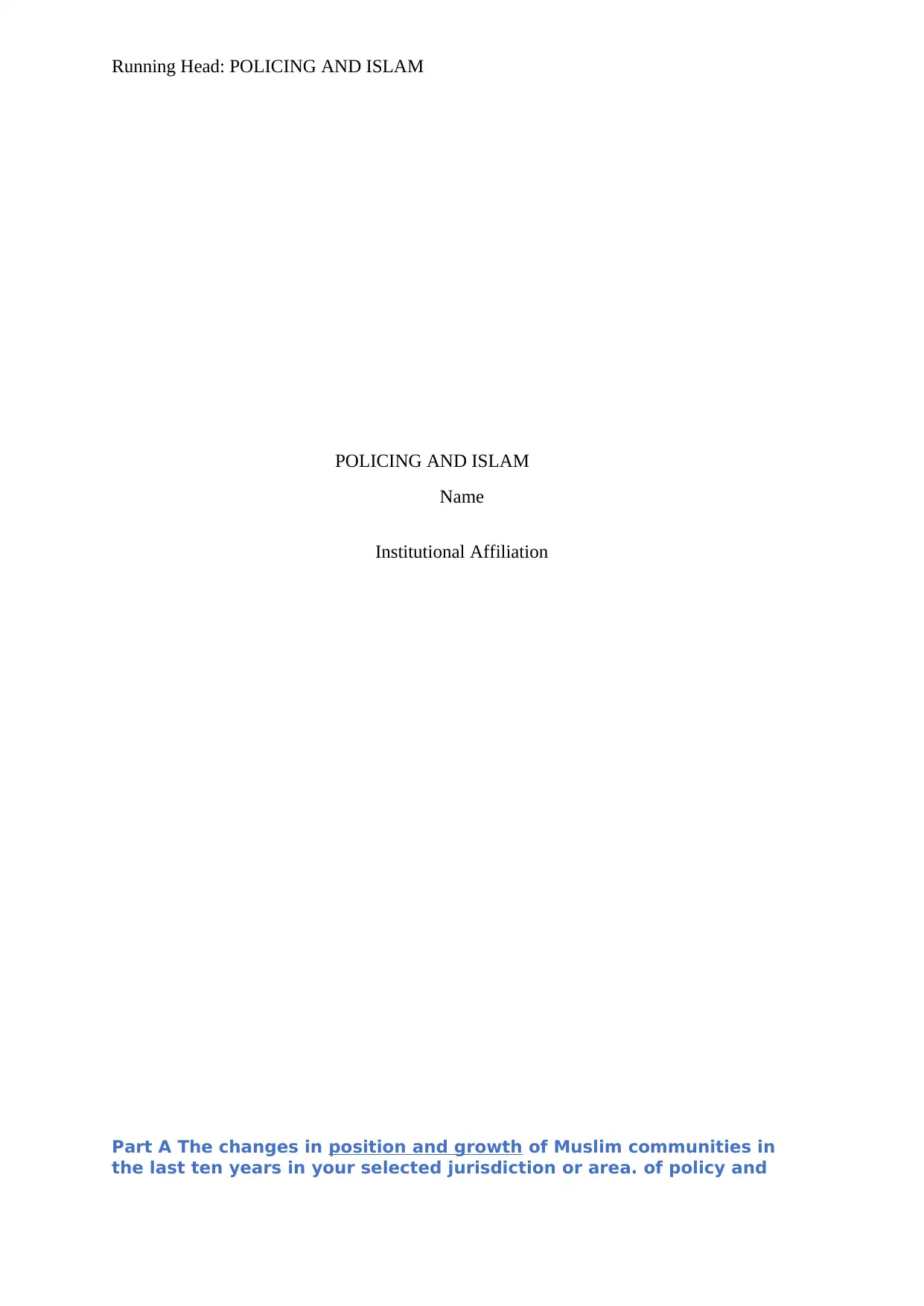
Running Head: POLICING AND ISLAM
POLICING AND ISLAM
Name
Institutional Affiliation
Part A The changes in position and growth of Muslim communities in
the last ten years in your selected jurisdiction or area. of policy and
POLICING AND ISLAM
Name
Institutional Affiliation
Part A The changes in position and growth of Muslim communities in
the last ten years in your selected jurisdiction or area. of policy and
Paraphrase This Document
Need a fresh take? Get an instant paraphrase of this document with our AI Paraphraser
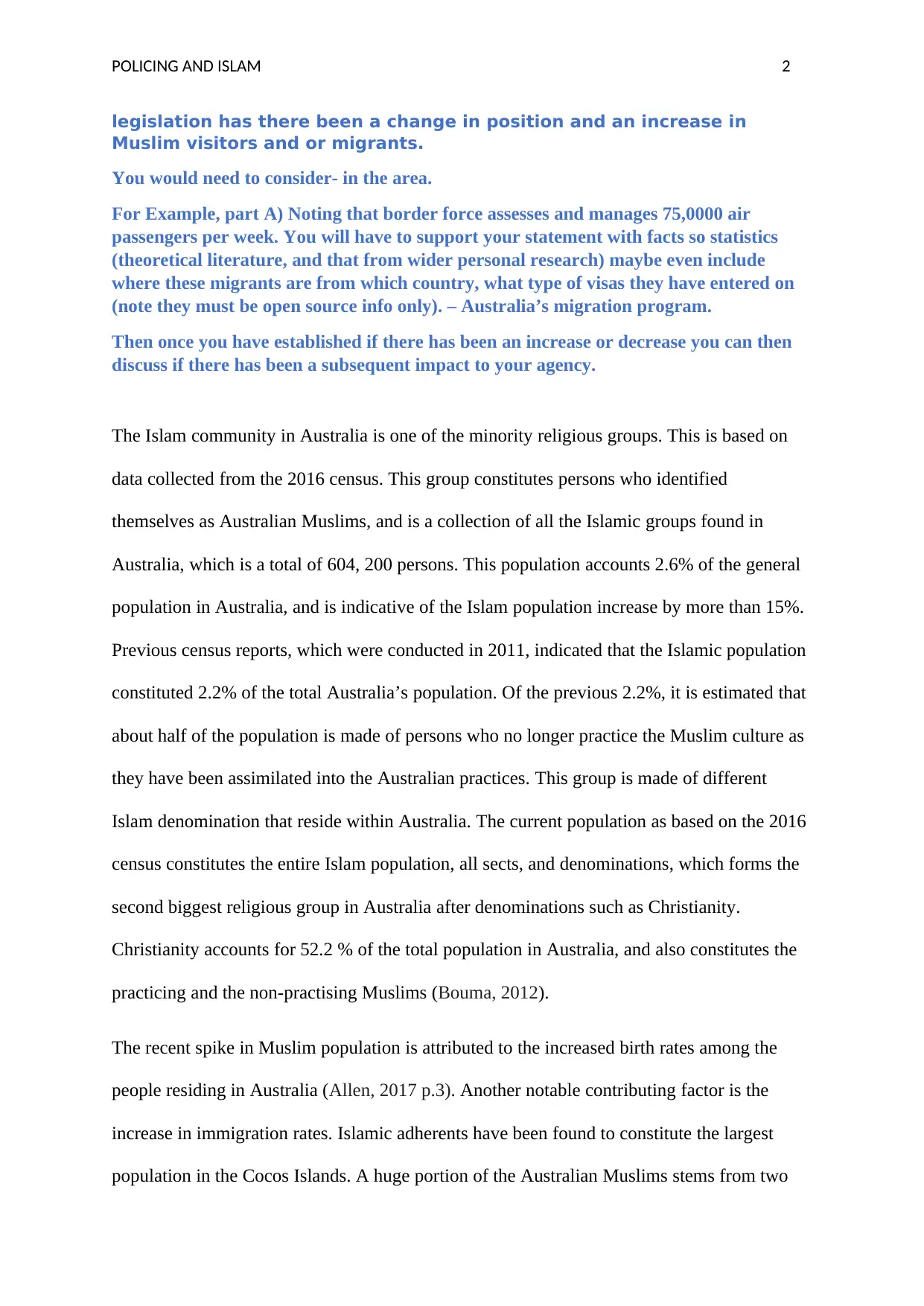
POLICING AND ISLAM 2
legislation has there been a change in position and an increase in
Muslim visitors and or migrants.
You would need to consider- in the area.
For Example, part A) Noting that border force assesses and manages 75,0000 air
passengers per week. You will have to support your statement with facts so statistics
(theoretical literature, and that from wider personal research) maybe even include
where these migrants are from which country, what type of visas they have entered on
(note they must be open source info only). – Australia’s migration program.
Then once you have established if there has been an increase or decrease you can then
discuss if there has been a subsequent impact to your agency.
The Islam community in Australia is one of the minority religious groups. This is based on
data collected from the 2016 census. This group constitutes persons who identified
themselves as Australian Muslims, and is a collection of all the Islamic groups found in
Australia, which is a total of 604, 200 persons. This population accounts 2.6% of the general
population in Australia, and is indicative of the Islam population increase by more than 15%.
Previous census reports, which were conducted in 2011, indicated that the Islamic population
constituted 2.2% of the total Australia’s population. Of the previous 2.2%, it is estimated that
about half of the population is made of persons who no longer practice the Muslim culture as
they have been assimilated into the Australian practices. This group is made of different
Islam denomination that reside within Australia. The current population as based on the 2016
census constitutes the entire Islam population, all sects, and denominations, which forms the
second biggest religious group in Australia after denominations such as Christianity.
Christianity accounts for 52.2 % of the total population in Australia, and also constitutes the
practicing and the non-practising Muslims (Bouma, 2012).
The recent spike in Muslim population is attributed to the increased birth rates among the
people residing in Australia (Allen, 2017 p.3). Another notable contributing factor is the
increase in immigration rates. Islamic adherents have been found to constitute the largest
population in the Cocos Islands. A huge portion of the Australian Muslims stems from two
legislation has there been a change in position and an increase in
Muslim visitors and or migrants.
You would need to consider- in the area.
For Example, part A) Noting that border force assesses and manages 75,0000 air
passengers per week. You will have to support your statement with facts so statistics
(theoretical literature, and that from wider personal research) maybe even include
where these migrants are from which country, what type of visas they have entered on
(note they must be open source info only). – Australia’s migration program.
Then once you have established if there has been an increase or decrease you can then
discuss if there has been a subsequent impact to your agency.
The Islam community in Australia is one of the minority religious groups. This is based on
data collected from the 2016 census. This group constitutes persons who identified
themselves as Australian Muslims, and is a collection of all the Islamic groups found in
Australia, which is a total of 604, 200 persons. This population accounts 2.6% of the general
population in Australia, and is indicative of the Islam population increase by more than 15%.
Previous census reports, which were conducted in 2011, indicated that the Islamic population
constituted 2.2% of the total Australia’s population. Of the previous 2.2%, it is estimated that
about half of the population is made of persons who no longer practice the Muslim culture as
they have been assimilated into the Australian practices. This group is made of different
Islam denomination that reside within Australia. The current population as based on the 2016
census constitutes the entire Islam population, all sects, and denominations, which forms the
second biggest religious group in Australia after denominations such as Christianity.
Christianity accounts for 52.2 % of the total population in Australia, and also constitutes the
practicing and the non-practising Muslims (Bouma, 2012).
The recent spike in Muslim population is attributed to the increased birth rates among the
people residing in Australia (Allen, 2017 p.3). Another notable contributing factor is the
increase in immigration rates. Islamic adherents have been found to constitute the largest
population in the Cocos Islands. A huge portion of the Australian Muslims stems from two
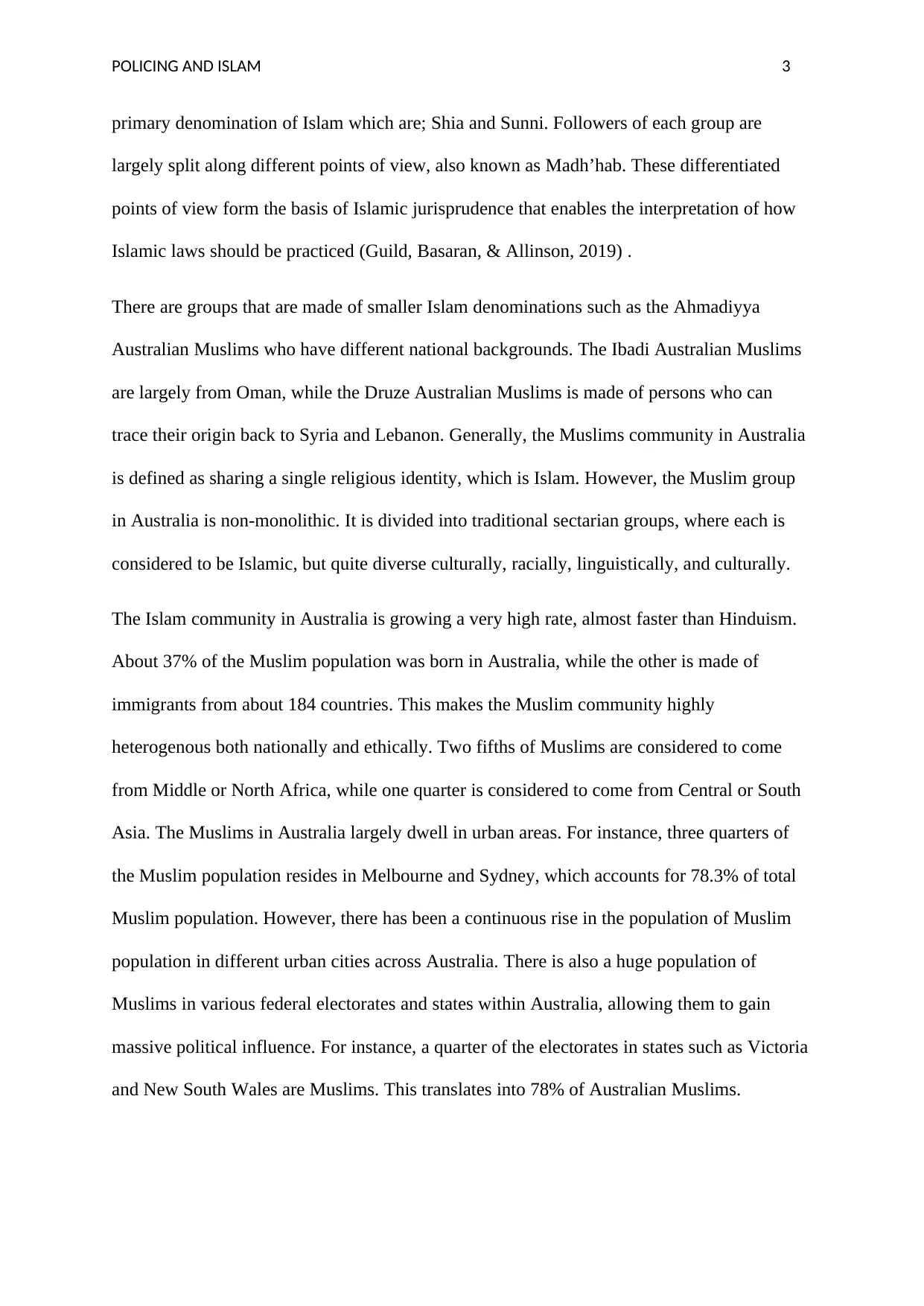
POLICING AND ISLAM 3
primary denomination of Islam which are; Shia and Sunni. Followers of each group are
largely split along different points of view, also known as Madh’hab. These differentiated
points of view form the basis of Islamic jurisprudence that enables the interpretation of how
Islamic laws should be practiced (Guild, Basaran, & Allinson, 2019) .
There are groups that are made of smaller Islam denominations such as the Ahmadiyya
Australian Muslims who have different national backgrounds. The Ibadi Australian Muslims
are largely from Oman, while the Druze Australian Muslims is made of persons who can
trace their origin back to Syria and Lebanon. Generally, the Muslims community in Australia
is defined as sharing a single religious identity, which is Islam. However, the Muslim group
in Australia is non-monolithic. It is divided into traditional sectarian groups, where each is
considered to be Islamic, but quite diverse culturally, racially, linguistically, and culturally.
The Islam community in Australia is growing a very high rate, almost faster than Hinduism.
About 37% of the Muslim population was born in Australia, while the other is made of
immigrants from about 184 countries. This makes the Muslim community highly
heterogenous both nationally and ethically. Two fifths of Muslims are considered to come
from Middle or North Africa, while one quarter is considered to come from Central or South
Asia. The Muslims in Australia largely dwell in urban areas. For instance, three quarters of
the Muslim population resides in Melbourne and Sydney, which accounts for 78.3% of total
Muslim population. However, there has been a continuous rise in the population of Muslim
population in different urban cities across Australia. There is also a huge population of
Muslims in various federal electorates and states within Australia, allowing them to gain
massive political influence. For instance, a quarter of the electorates in states such as Victoria
and New South Wales are Muslims. This translates into 78% of Australian Muslims.
primary denomination of Islam which are; Shia and Sunni. Followers of each group are
largely split along different points of view, also known as Madh’hab. These differentiated
points of view form the basis of Islamic jurisprudence that enables the interpretation of how
Islamic laws should be practiced (Guild, Basaran, & Allinson, 2019) .
There are groups that are made of smaller Islam denominations such as the Ahmadiyya
Australian Muslims who have different national backgrounds. The Ibadi Australian Muslims
are largely from Oman, while the Druze Australian Muslims is made of persons who can
trace their origin back to Syria and Lebanon. Generally, the Muslims community in Australia
is defined as sharing a single religious identity, which is Islam. However, the Muslim group
in Australia is non-monolithic. It is divided into traditional sectarian groups, where each is
considered to be Islamic, but quite diverse culturally, racially, linguistically, and culturally.
The Islam community in Australia is growing a very high rate, almost faster than Hinduism.
About 37% of the Muslim population was born in Australia, while the other is made of
immigrants from about 184 countries. This makes the Muslim community highly
heterogenous both nationally and ethically. Two fifths of Muslims are considered to come
from Middle or North Africa, while one quarter is considered to come from Central or South
Asia. The Muslims in Australia largely dwell in urban areas. For instance, three quarters of
the Muslim population resides in Melbourne and Sydney, which accounts for 78.3% of total
Muslim population. However, there has been a continuous rise in the population of Muslim
population in different urban cities across Australia. There is also a huge population of
Muslims in various federal electorates and states within Australia, allowing them to gain
massive political influence. For instance, a quarter of the electorates in states such as Victoria
and New South Wales are Muslims. This translates into 78% of Australian Muslims.
⊘ This is a preview!⊘
Do you want full access?
Subscribe today to unlock all pages.

Trusted by 1+ million students worldwide
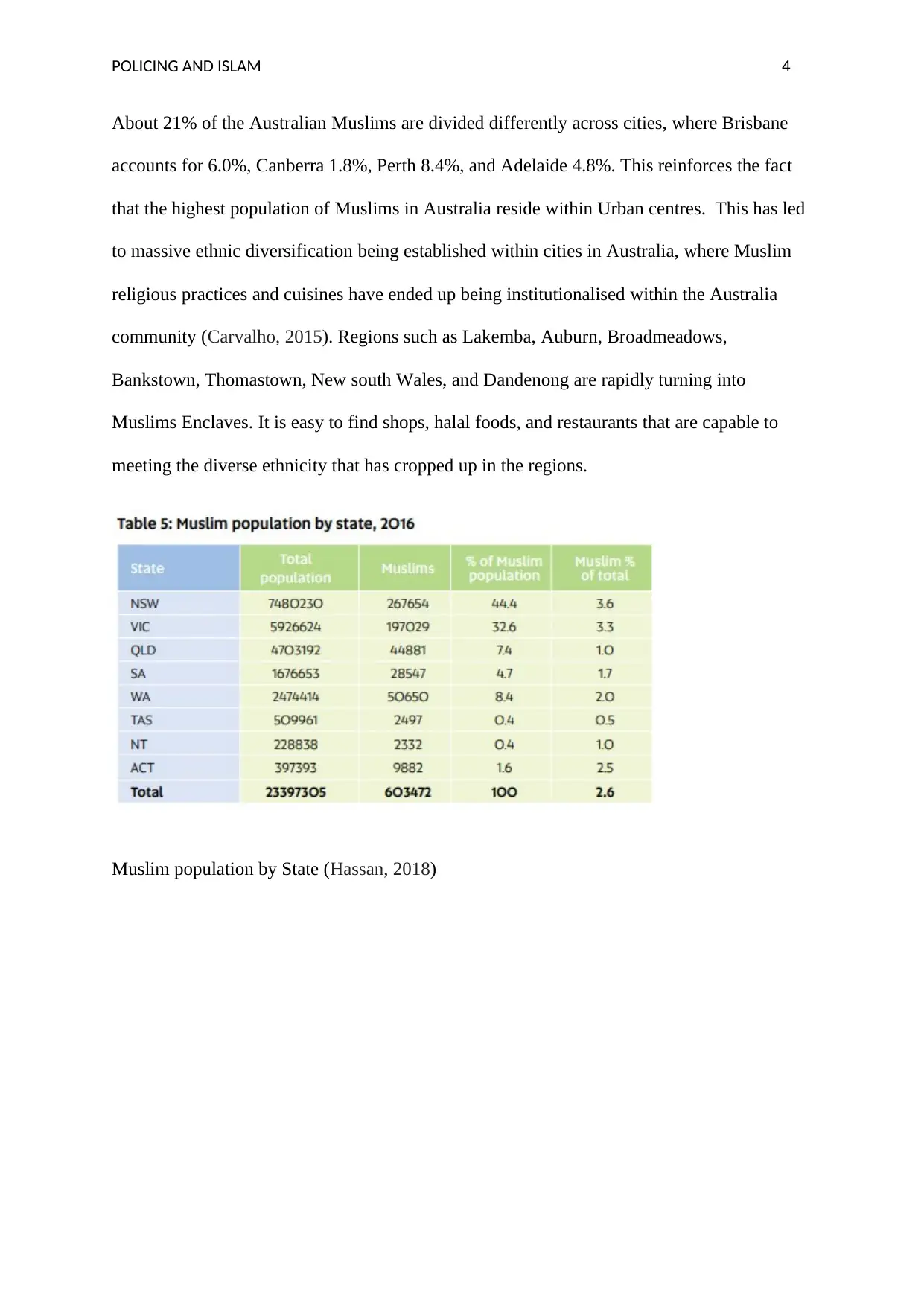
POLICING AND ISLAM 4
About 21% of the Australian Muslims are divided differently across cities, where Brisbane
accounts for 6.0%, Canberra 1.8%, Perth 8.4%, and Adelaide 4.8%. This reinforces the fact
that the highest population of Muslims in Australia reside within Urban centres. This has led
to massive ethnic diversification being established within cities in Australia, where Muslim
religious practices and cuisines have ended up being institutionalised within the Australia
community (Carvalho, 2015). Regions such as Lakemba, Auburn, Broadmeadows,
Bankstown, Thomastown, New south Wales, and Dandenong are rapidly turning into
Muslims Enclaves. It is easy to find shops, halal foods, and restaurants that are capable to
meeting the diverse ethnicity that has cropped up in the regions.
Muslim population by State (Hassan, 2018)
About 21% of the Australian Muslims are divided differently across cities, where Brisbane
accounts for 6.0%, Canberra 1.8%, Perth 8.4%, and Adelaide 4.8%. This reinforces the fact
that the highest population of Muslims in Australia reside within Urban centres. This has led
to massive ethnic diversification being established within cities in Australia, where Muslim
religious practices and cuisines have ended up being institutionalised within the Australia
community (Carvalho, 2015). Regions such as Lakemba, Auburn, Broadmeadows,
Bankstown, Thomastown, New south Wales, and Dandenong are rapidly turning into
Muslims Enclaves. It is easy to find shops, halal foods, and restaurants that are capable to
meeting the diverse ethnicity that has cropped up in the regions.
Muslim population by State (Hassan, 2018)
Paraphrase This Document
Need a fresh take? Get an instant paraphrase of this document with our AI Paraphraser
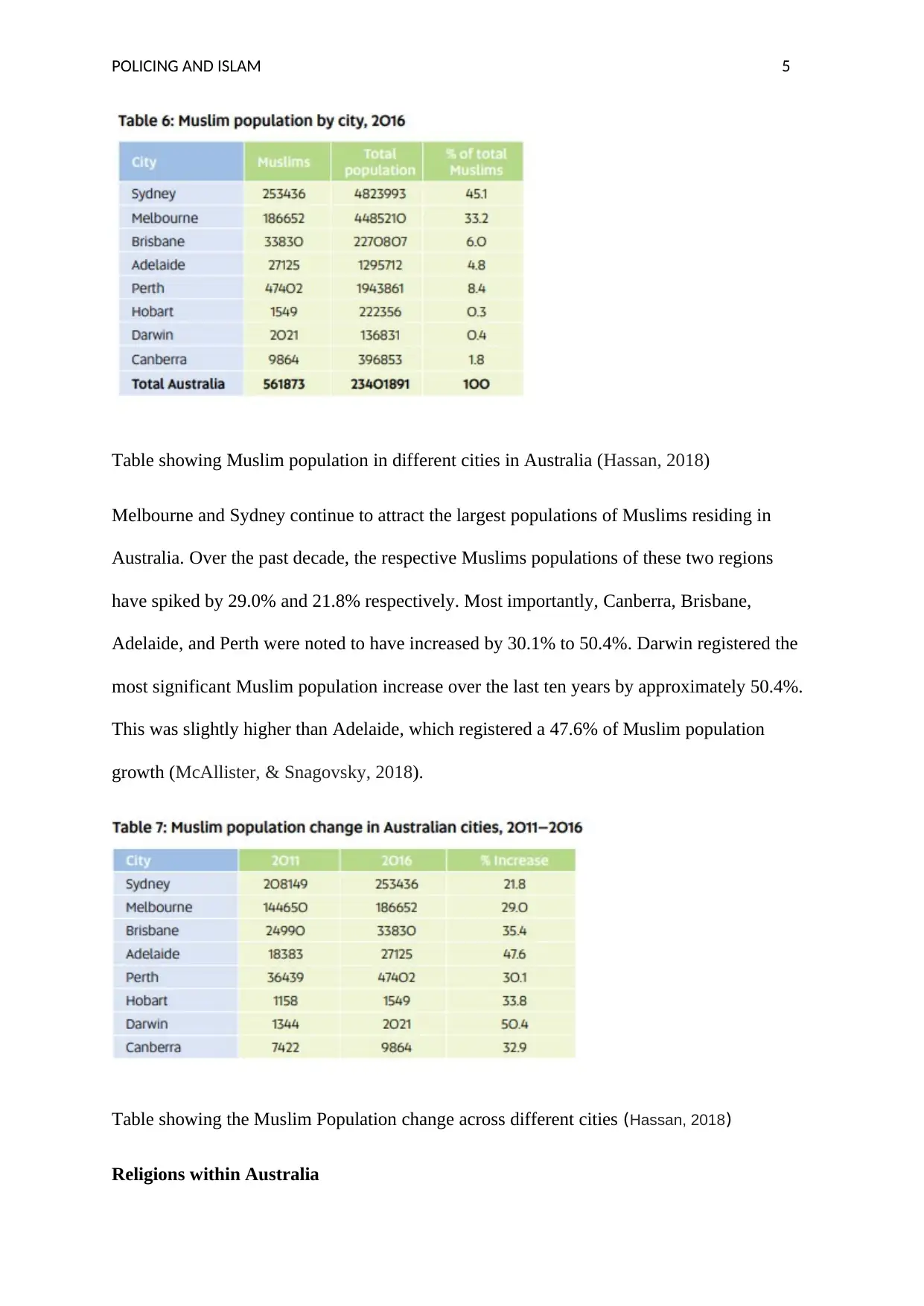
POLICING AND ISLAM 5
Table showing Muslim population in different cities in Australia (Hassan, 2018)
Melbourne and Sydney continue to attract the largest populations of Muslims residing in
Australia. Over the past decade, the respective Muslims populations of these two regions
have spiked by 29.0% and 21.8% respectively. Most importantly, Canberra, Brisbane,
Adelaide, and Perth were noted to have increased by 30.1% to 50.4%. Darwin registered the
most significant Muslim population increase over the last ten years by approximately 50.4%.
This was slightly higher than Adelaide, which registered a 47.6% of Muslim population
growth (McAllister, & Snagovsky, 2018).
Table showing the Muslim Population change across different cities (Hassan, 2018)
Religions within Australia
Table showing Muslim population in different cities in Australia (Hassan, 2018)
Melbourne and Sydney continue to attract the largest populations of Muslims residing in
Australia. Over the past decade, the respective Muslims populations of these two regions
have spiked by 29.0% and 21.8% respectively. Most importantly, Canberra, Brisbane,
Adelaide, and Perth were noted to have increased by 30.1% to 50.4%. Darwin registered the
most significant Muslim population increase over the last ten years by approximately 50.4%.
This was slightly higher than Adelaide, which registered a 47.6% of Muslim population
growth (McAllister, & Snagovsky, 2018).
Table showing the Muslim Population change across different cities (Hassan, 2018)
Religions within Australia
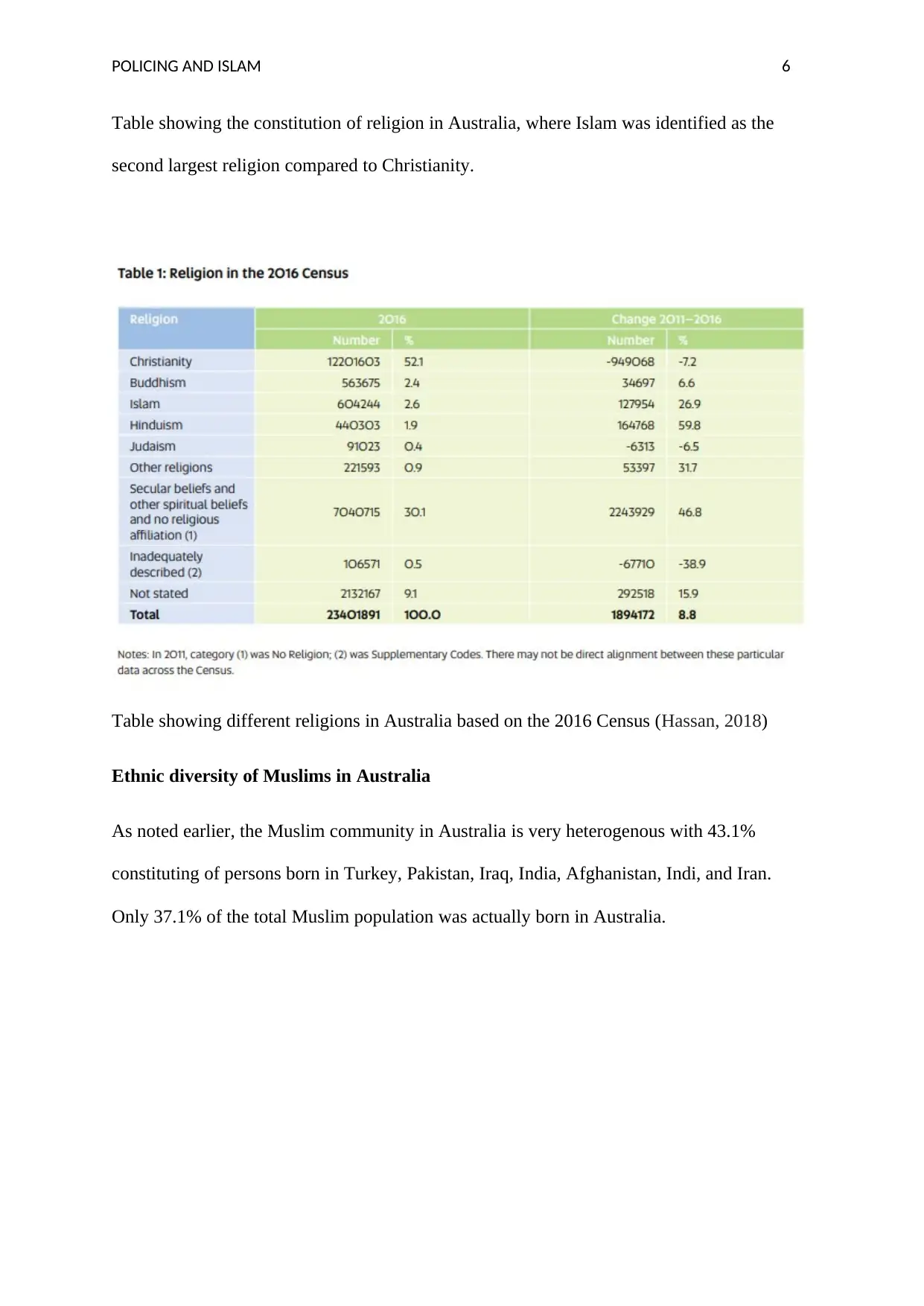
POLICING AND ISLAM 6
Table showing the constitution of religion in Australia, where Islam was identified as the
second largest religion compared to Christianity.
Table showing different religions in Australia based on the 2016 Census (Hassan, 2018)
Ethnic diversity of Muslims in Australia
As noted earlier, the Muslim community in Australia is very heterogenous with 43.1%
constituting of persons born in Turkey, Pakistan, Iraq, India, Afghanistan, Indi, and Iran.
Only 37.1% of the total Muslim population was actually born in Australia.
Table showing the constitution of religion in Australia, where Islam was identified as the
second largest religion compared to Christianity.
Table showing different religions in Australia based on the 2016 Census (Hassan, 2018)
Ethnic diversity of Muslims in Australia
As noted earlier, the Muslim community in Australia is very heterogenous with 43.1%
constituting of persons born in Turkey, Pakistan, Iraq, India, Afghanistan, Indi, and Iran.
Only 37.1% of the total Muslim population was actually born in Australia.
⊘ This is a preview!⊘
Do you want full access?
Subscribe today to unlock all pages.

Trusted by 1+ million students worldwide
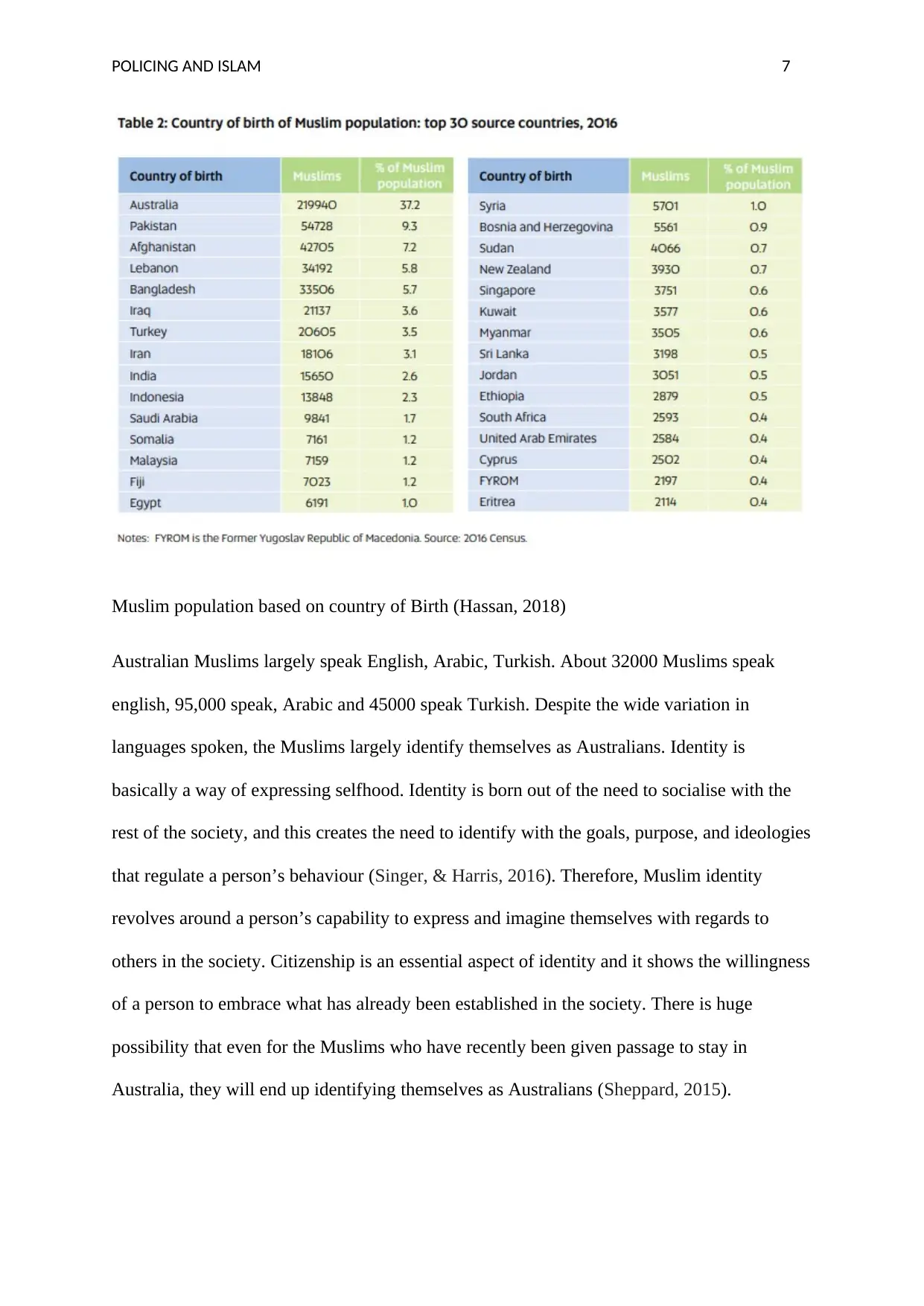
POLICING AND ISLAM 7
Muslim population based on country of Birth (Hassan, 2018)
Australian Muslims largely speak English, Arabic, Turkish. About 32000 Muslims speak
english, 95,000 speak, Arabic and 45000 speak Turkish. Despite the wide variation in
languages spoken, the Muslims largely identify themselves as Australians. Identity is
basically a way of expressing selfhood. Identity is born out of the need to socialise with the
rest of the society, and this creates the need to identify with the goals, purpose, and ideologies
that regulate a person’s behaviour (Singer, & Harris, 2016). Therefore, Muslim identity
revolves around a person’s capability to express and imagine themselves with regards to
others in the society. Citizenship is an essential aspect of identity and it shows the willingness
of a person to embrace what has already been established in the society. There is huge
possibility that even for the Muslims who have recently been given passage to stay in
Australia, they will end up identifying themselves as Australians (Sheppard, 2015).
Muslim population based on country of Birth (Hassan, 2018)
Australian Muslims largely speak English, Arabic, Turkish. About 32000 Muslims speak
english, 95,000 speak, Arabic and 45000 speak Turkish. Despite the wide variation in
languages spoken, the Muslims largely identify themselves as Australians. Identity is
basically a way of expressing selfhood. Identity is born out of the need to socialise with the
rest of the society, and this creates the need to identify with the goals, purpose, and ideologies
that regulate a person’s behaviour (Singer, & Harris, 2016). Therefore, Muslim identity
revolves around a person’s capability to express and imagine themselves with regards to
others in the society. Citizenship is an essential aspect of identity and it shows the willingness
of a person to embrace what has already been established in the society. There is huge
possibility that even for the Muslims who have recently been given passage to stay in
Australia, they will end up identifying themselves as Australians (Sheppard, 2015).
Paraphrase This Document
Need a fresh take? Get an instant paraphrase of this document with our AI Paraphraser
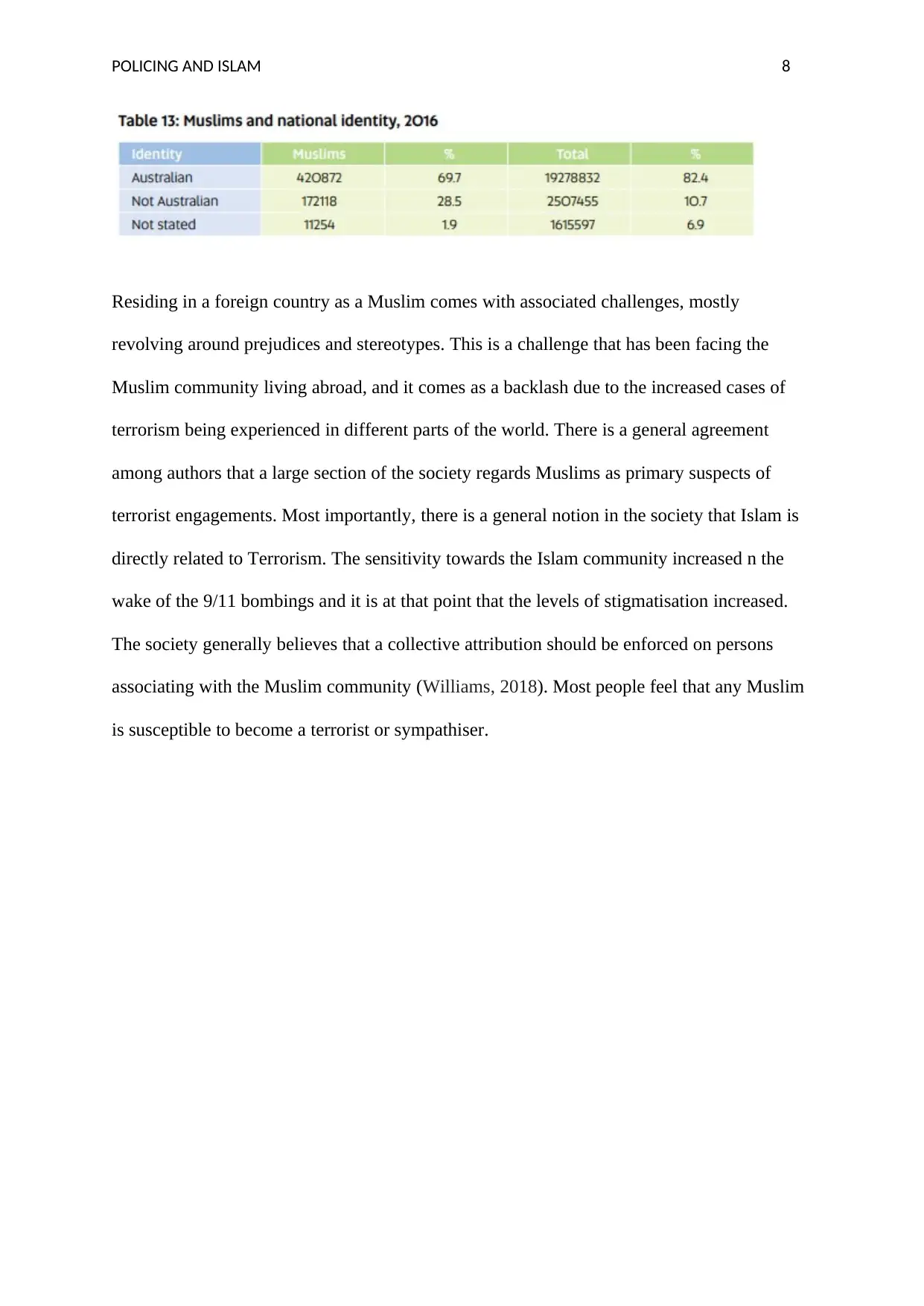
POLICING AND ISLAM 8
Residing in a foreign country as a Muslim comes with associated challenges, mostly
revolving around prejudices and stereotypes. This is a challenge that has been facing the
Muslim community living abroad, and it comes as a backlash due to the increased cases of
terrorism being experienced in different parts of the world. There is a general agreement
among authors that a large section of the society regards Muslims as primary suspects of
terrorist engagements. Most importantly, there is a general notion in the society that Islam is
directly related to Terrorism. The sensitivity towards the Islam community increased n the
wake of the 9/11 bombings and it is at that point that the levels of stigmatisation increased.
The society generally believes that a collective attribution should be enforced on persons
associating with the Muslim community (Williams, 2018). Most people feel that any Muslim
is susceptible to become a terrorist or sympathiser.
Residing in a foreign country as a Muslim comes with associated challenges, mostly
revolving around prejudices and stereotypes. This is a challenge that has been facing the
Muslim community living abroad, and it comes as a backlash due to the increased cases of
terrorism being experienced in different parts of the world. There is a general agreement
among authors that a large section of the society regards Muslims as primary suspects of
terrorist engagements. Most importantly, there is a general notion in the society that Islam is
directly related to Terrorism. The sensitivity towards the Islam community increased n the
wake of the 9/11 bombings and it is at that point that the levels of stigmatisation increased.
The society generally believes that a collective attribution should be enforced on persons
associating with the Muslim community (Williams, 2018). Most people feel that any Muslim
is susceptible to become a terrorist or sympathiser.
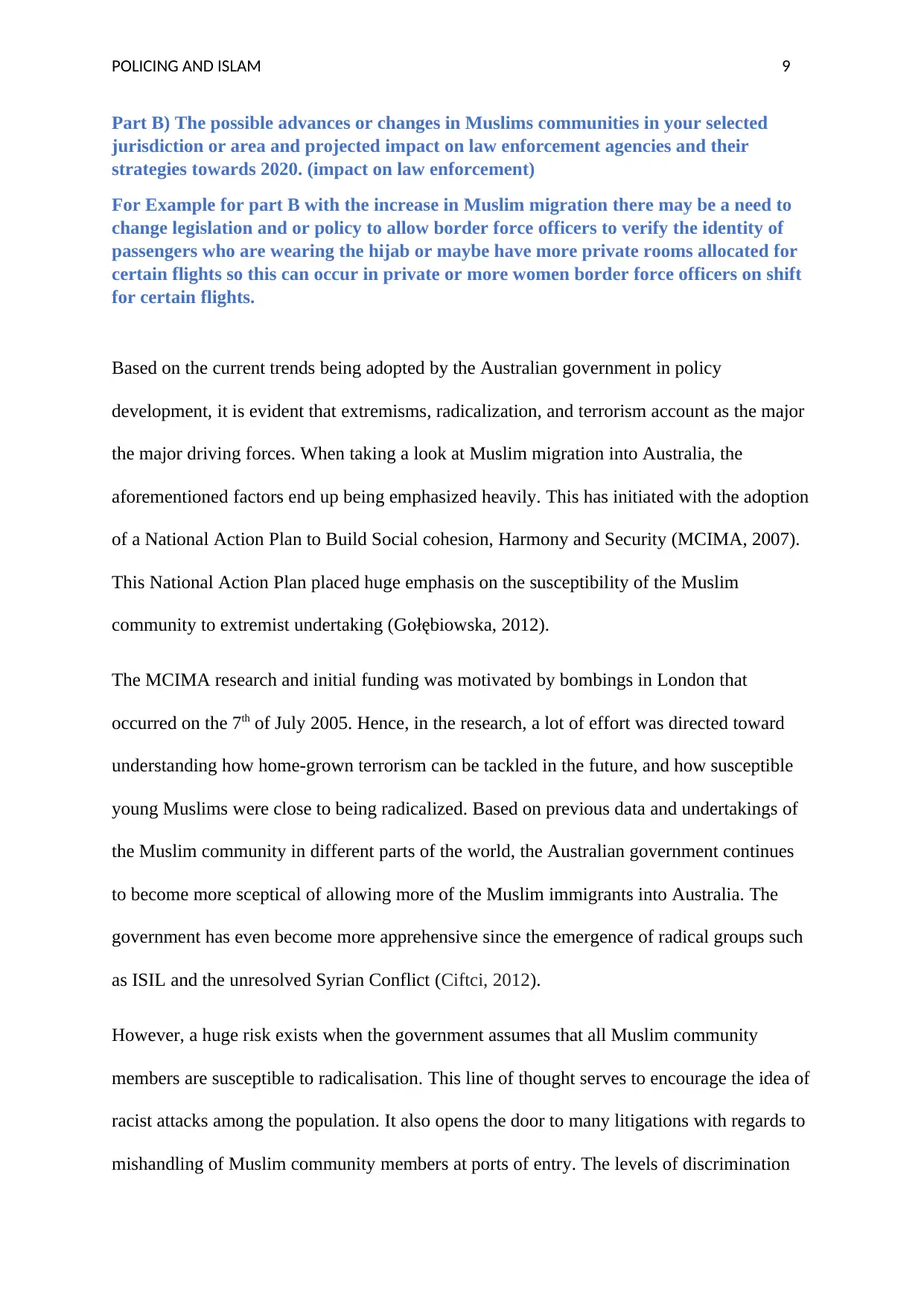
POLICING AND ISLAM 9
Part B) The possible advances or changes in Muslims communities in your selected
jurisdiction or area and projected impact on law enforcement agencies and their
strategies towards 2020. (impact on law enforcement)
For Example for part B with the increase in Muslim migration there may be a need to
change legislation and or policy to allow border force officers to verify the identity of
passengers who are wearing the hijab or maybe have more private rooms allocated for
certain flights so this can occur in private or more women border force officers on shift
for certain flights.
Based on the current trends being adopted by the Australian government in policy
development, it is evident that extremisms, radicalization, and terrorism account as the major
the major driving forces. When taking a look at Muslim migration into Australia, the
aforementioned factors end up being emphasized heavily. This has initiated with the adoption
of a National Action Plan to Build Social cohesion, Harmony and Security (MCIMA, 2007).
This National Action Plan placed huge emphasis on the susceptibility of the Muslim
community to extremist undertaking (Gołębiowska, 2012).
The MCIMA research and initial funding was motivated by bombings in London that
occurred on the 7th of July 2005. Hence, in the research, a lot of effort was directed toward
understanding how home-grown terrorism can be tackled in the future, and how susceptible
young Muslims were close to being radicalized. Based on previous data and undertakings of
the Muslim community in different parts of the world, the Australian government continues
to become more sceptical of allowing more of the Muslim immigrants into Australia. The
government has even become more apprehensive since the emergence of radical groups such
as ISIL and the unresolved Syrian Conflict (Ciftci, 2012).
However, a huge risk exists when the government assumes that all Muslim community
members are susceptible to radicalisation. This line of thought serves to encourage the idea of
racist attacks among the population. It also opens the door to many litigations with regards to
mishandling of Muslim community members at ports of entry. The levels of discrimination
Part B) The possible advances or changes in Muslims communities in your selected
jurisdiction or area and projected impact on law enforcement agencies and their
strategies towards 2020. (impact on law enforcement)
For Example for part B with the increase in Muslim migration there may be a need to
change legislation and or policy to allow border force officers to verify the identity of
passengers who are wearing the hijab or maybe have more private rooms allocated for
certain flights so this can occur in private or more women border force officers on shift
for certain flights.
Based on the current trends being adopted by the Australian government in policy
development, it is evident that extremisms, radicalization, and terrorism account as the major
the major driving forces. When taking a look at Muslim migration into Australia, the
aforementioned factors end up being emphasized heavily. This has initiated with the adoption
of a National Action Plan to Build Social cohesion, Harmony and Security (MCIMA, 2007).
This National Action Plan placed huge emphasis on the susceptibility of the Muslim
community to extremist undertaking (Gołębiowska, 2012).
The MCIMA research and initial funding was motivated by bombings in London that
occurred on the 7th of July 2005. Hence, in the research, a lot of effort was directed toward
understanding how home-grown terrorism can be tackled in the future, and how susceptible
young Muslims were close to being radicalized. Based on previous data and undertakings of
the Muslim community in different parts of the world, the Australian government continues
to become more sceptical of allowing more of the Muslim immigrants into Australia. The
government has even become more apprehensive since the emergence of radical groups such
as ISIL and the unresolved Syrian Conflict (Ciftci, 2012).
However, a huge risk exists when the government assumes that all Muslim community
members are susceptible to radicalisation. This line of thought serves to encourage the idea of
racist attacks among the population. It also opens the door to many litigations with regards to
mishandling of Muslim community members at ports of entry. The levels of discrimination
⊘ This is a preview!⊘
Do you want full access?
Subscribe today to unlock all pages.

Trusted by 1+ million students worldwide
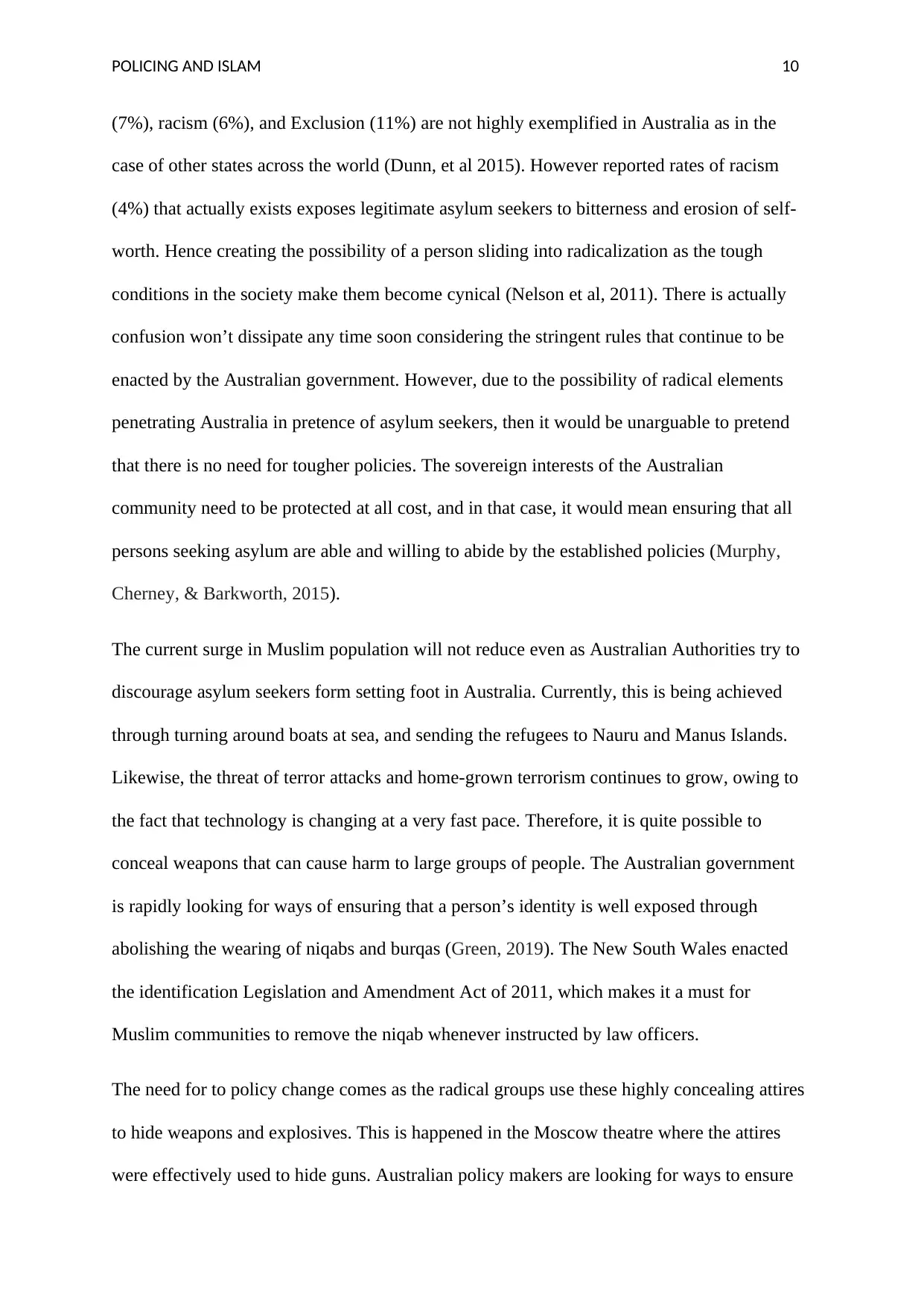
POLICING AND ISLAM 10
(7%), racism (6%), and Exclusion (11%) are not highly exemplified in Australia as in the
case of other states across the world (Dunn, et al 2015). However reported rates of racism
(4%) that actually exists exposes legitimate asylum seekers to bitterness and erosion of self-
worth. Hence creating the possibility of a person sliding into radicalization as the tough
conditions in the society make them become cynical (Nelson et al, 2011). There is actually
confusion won’t dissipate any time soon considering the stringent rules that continue to be
enacted by the Australian government. However, due to the possibility of radical elements
penetrating Australia in pretence of asylum seekers, then it would be unarguable to pretend
that there is no need for tougher policies. The sovereign interests of the Australian
community need to be protected at all cost, and in that case, it would mean ensuring that all
persons seeking asylum are able and willing to abide by the established policies (Murphy,
Cherney, & Barkworth, 2015).
The current surge in Muslim population will not reduce even as Australian Authorities try to
discourage asylum seekers form setting foot in Australia. Currently, this is being achieved
through turning around boats at sea, and sending the refugees to Nauru and Manus Islands.
Likewise, the threat of terror attacks and home-grown terrorism continues to grow, owing to
the fact that technology is changing at a very fast pace. Therefore, it is quite possible to
conceal weapons that can cause harm to large groups of people. The Australian government
is rapidly looking for ways of ensuring that a person’s identity is well exposed through
abolishing the wearing of niqabs and burqas (Green, 2019). The New South Wales enacted
the identification Legislation and Amendment Act of 2011, which makes it a must for
Muslim communities to remove the niqab whenever instructed by law officers.
The need for to policy change comes as the radical groups use these highly concealing attires
to hide weapons and explosives. This is happened in the Moscow theatre where the attires
were effectively used to hide guns. Australian policy makers are looking for ways to ensure
(7%), racism (6%), and Exclusion (11%) are not highly exemplified in Australia as in the
case of other states across the world (Dunn, et al 2015). However reported rates of racism
(4%) that actually exists exposes legitimate asylum seekers to bitterness and erosion of self-
worth. Hence creating the possibility of a person sliding into radicalization as the tough
conditions in the society make them become cynical (Nelson et al, 2011). There is actually
confusion won’t dissipate any time soon considering the stringent rules that continue to be
enacted by the Australian government. However, due to the possibility of radical elements
penetrating Australia in pretence of asylum seekers, then it would be unarguable to pretend
that there is no need for tougher policies. The sovereign interests of the Australian
community need to be protected at all cost, and in that case, it would mean ensuring that all
persons seeking asylum are able and willing to abide by the established policies (Murphy,
Cherney, & Barkworth, 2015).
The current surge in Muslim population will not reduce even as Australian Authorities try to
discourage asylum seekers form setting foot in Australia. Currently, this is being achieved
through turning around boats at sea, and sending the refugees to Nauru and Manus Islands.
Likewise, the threat of terror attacks and home-grown terrorism continues to grow, owing to
the fact that technology is changing at a very fast pace. Therefore, it is quite possible to
conceal weapons that can cause harm to large groups of people. The Australian government
is rapidly looking for ways of ensuring that a person’s identity is well exposed through
abolishing the wearing of niqabs and burqas (Green, 2019). The New South Wales enacted
the identification Legislation and Amendment Act of 2011, which makes it a must for
Muslim communities to remove the niqab whenever instructed by law officers.
The need for to policy change comes as the radical groups use these highly concealing attires
to hide weapons and explosives. This is happened in the Moscow theatre where the attires
were effectively used to hide guns. Australian policy makers are looking for ways to ensure
Paraphrase This Document
Need a fresh take? Get an instant paraphrase of this document with our AI Paraphraser
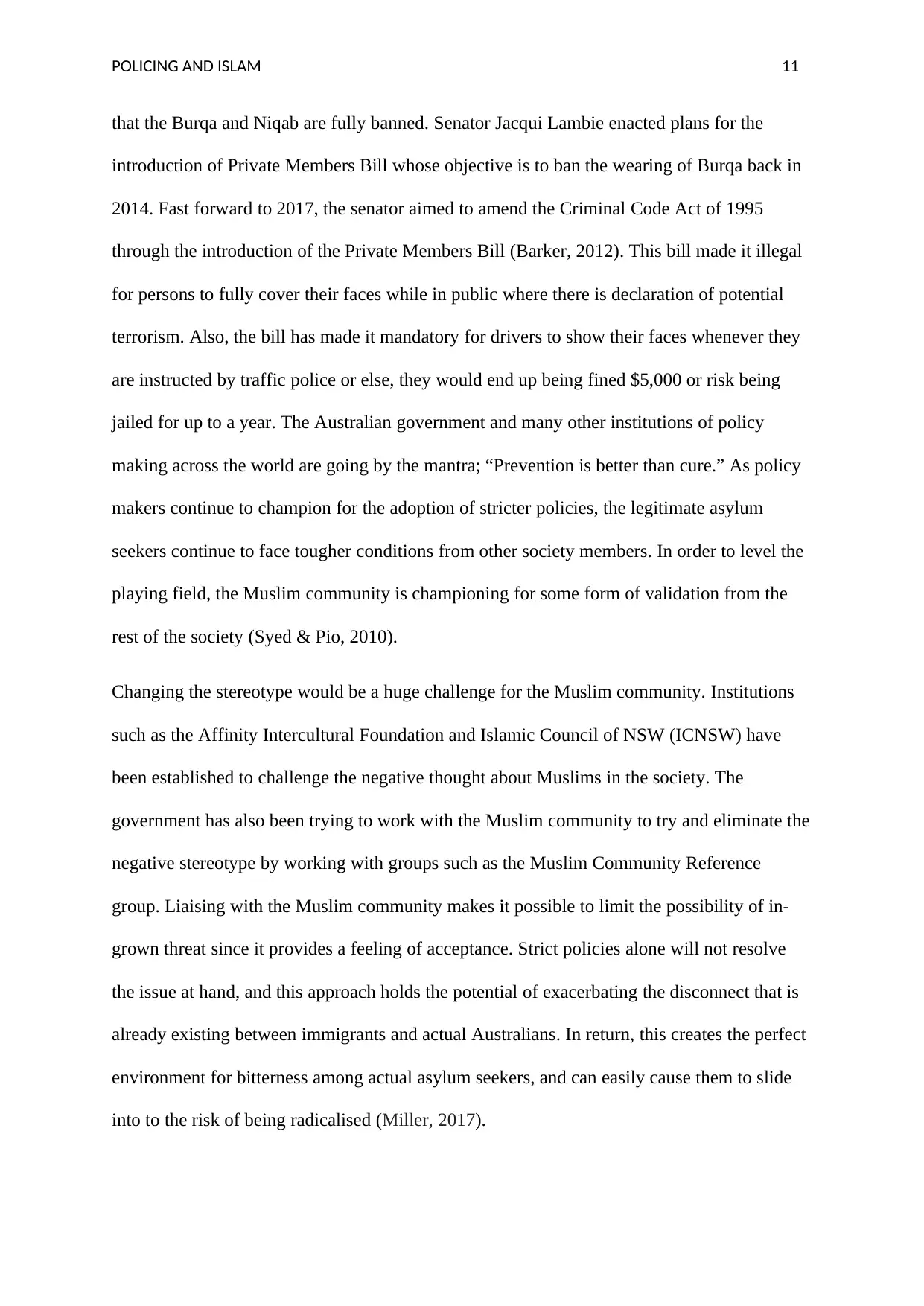
POLICING AND ISLAM 11
that the Burqa and Niqab are fully banned. Senator Jacqui Lambie enacted plans for the
introduction of Private Members Bill whose objective is to ban the wearing of Burqa back in
2014. Fast forward to 2017, the senator aimed to amend the Criminal Code Act of 1995
through the introduction of the Private Members Bill (Barker, 2012). This bill made it illegal
for persons to fully cover their faces while in public where there is declaration of potential
terrorism. Also, the bill has made it mandatory for drivers to show their faces whenever they
are instructed by traffic police or else, they would end up being fined $5,000 or risk being
jailed for up to a year. The Australian government and many other institutions of policy
making across the world are going by the mantra; “Prevention is better than cure.” As policy
makers continue to champion for the adoption of stricter policies, the legitimate asylum
seekers continue to face tougher conditions from other society members. In order to level the
playing field, the Muslim community is championing for some form of validation from the
rest of the society (Syed & Pio, 2010).
Changing the stereotype would be a huge challenge for the Muslim community. Institutions
such as the Affinity Intercultural Foundation and Islamic Council of NSW (ICNSW) have
been established to challenge the negative thought about Muslims in the society. The
government has also been trying to work with the Muslim community to try and eliminate the
negative stereotype by working with groups such as the Muslim Community Reference
group. Liaising with the Muslim community makes it possible to limit the possibility of in-
grown threat since it provides a feeling of acceptance. Strict policies alone will not resolve
the issue at hand, and this approach holds the potential of exacerbating the disconnect that is
already existing between immigrants and actual Australians. In return, this creates the perfect
environment for bitterness among actual asylum seekers, and can easily cause them to slide
into to the risk of being radicalised (Miller, 2017).
that the Burqa and Niqab are fully banned. Senator Jacqui Lambie enacted plans for the
introduction of Private Members Bill whose objective is to ban the wearing of Burqa back in
2014. Fast forward to 2017, the senator aimed to amend the Criminal Code Act of 1995
through the introduction of the Private Members Bill (Barker, 2012). This bill made it illegal
for persons to fully cover their faces while in public where there is declaration of potential
terrorism. Also, the bill has made it mandatory for drivers to show their faces whenever they
are instructed by traffic police or else, they would end up being fined $5,000 or risk being
jailed for up to a year. The Australian government and many other institutions of policy
making across the world are going by the mantra; “Prevention is better than cure.” As policy
makers continue to champion for the adoption of stricter policies, the legitimate asylum
seekers continue to face tougher conditions from other society members. In order to level the
playing field, the Muslim community is championing for some form of validation from the
rest of the society (Syed & Pio, 2010).
Changing the stereotype would be a huge challenge for the Muslim community. Institutions
such as the Affinity Intercultural Foundation and Islamic Council of NSW (ICNSW) have
been established to challenge the negative thought about Muslims in the society. The
government has also been trying to work with the Muslim community to try and eliminate the
negative stereotype by working with groups such as the Muslim Community Reference
group. Liaising with the Muslim community makes it possible to limit the possibility of in-
grown threat since it provides a feeling of acceptance. Strict policies alone will not resolve
the issue at hand, and this approach holds the potential of exacerbating the disconnect that is
already existing between immigrants and actual Australians. In return, this creates the perfect
environment for bitterness among actual asylum seekers, and can easily cause them to slide
into to the risk of being radicalised (Miller, 2017).
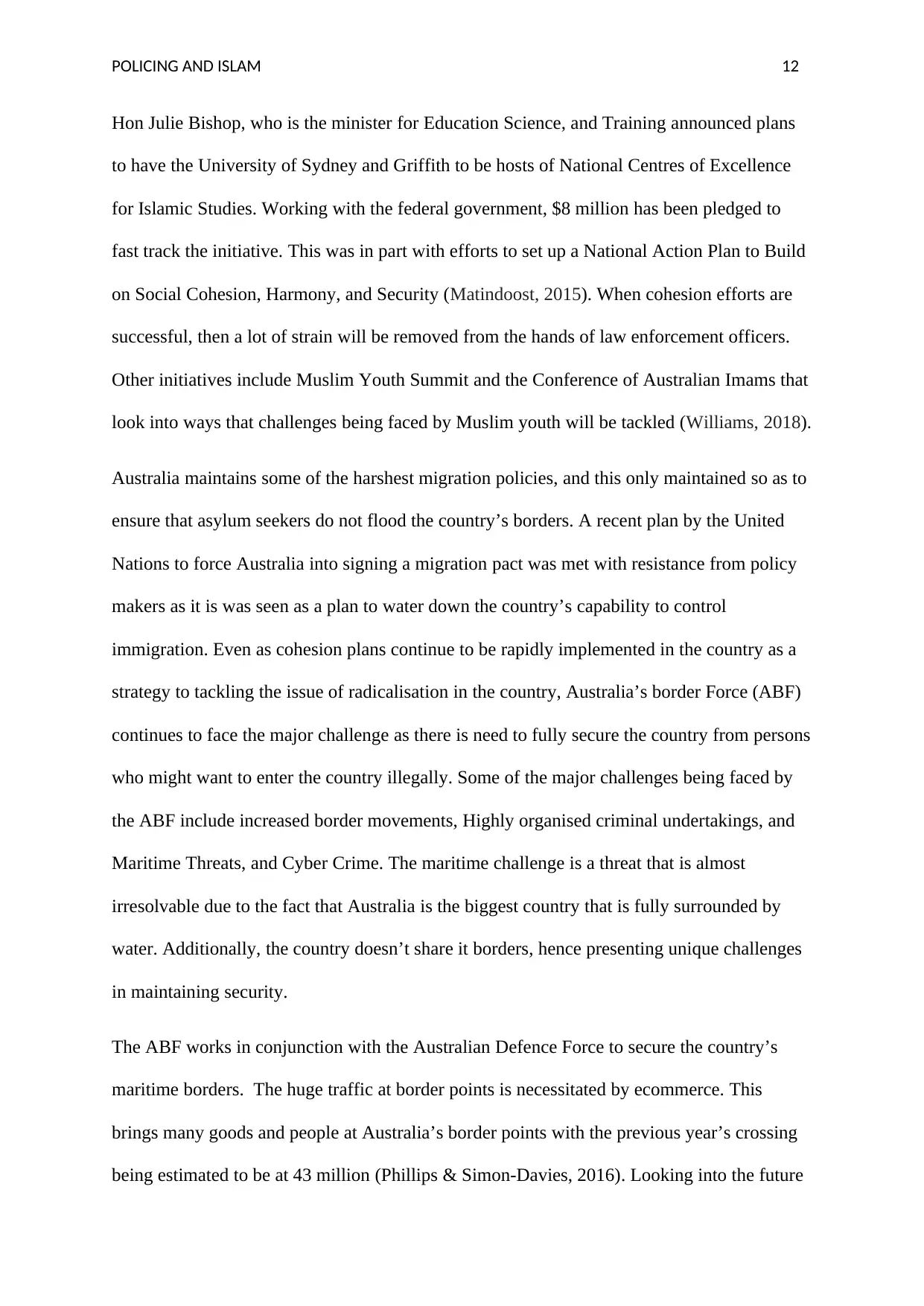
POLICING AND ISLAM 12
Hon Julie Bishop, who is the minister for Education Science, and Training announced plans
to have the University of Sydney and Griffith to be hosts of National Centres of Excellence
for Islamic Studies. Working with the federal government, $8 million has been pledged to
fast track the initiative. This was in part with efforts to set up a National Action Plan to Build
on Social Cohesion, Harmony, and Security (Matindoost, 2015). When cohesion efforts are
successful, then a lot of strain will be removed from the hands of law enforcement officers.
Other initiatives include Muslim Youth Summit and the Conference of Australian Imams that
look into ways that challenges being faced by Muslim youth will be tackled (Williams, 2018).
Australia maintains some of the harshest migration policies, and this only maintained so as to
ensure that asylum seekers do not flood the country’s borders. A recent plan by the United
Nations to force Australia into signing a migration pact was met with resistance from policy
makers as it is was seen as a plan to water down the country’s capability to control
immigration. Even as cohesion plans continue to be rapidly implemented in the country as a
strategy to tackling the issue of radicalisation in the country, Australia’s border Force (ABF)
continues to face the major challenge as there is need to fully secure the country from persons
who might want to enter the country illegally. Some of the major challenges being faced by
the ABF include increased border movements, Highly organised criminal undertakings, and
Maritime Threats, and Cyber Crime. The maritime challenge is a threat that is almost
irresolvable due to the fact that Australia is the biggest country that is fully surrounded by
water. Additionally, the country doesn’t share it borders, hence presenting unique challenges
in maintaining security.
The ABF works in conjunction with the Australian Defence Force to secure the country’s
maritime borders. The huge traffic at border points is necessitated by ecommerce. This
brings many goods and people at Australia’s border points with the previous year’s crossing
being estimated to be at 43 million (Phillips & Simon-Davies, 2016). Looking into the future
Hon Julie Bishop, who is the minister for Education Science, and Training announced plans
to have the University of Sydney and Griffith to be hosts of National Centres of Excellence
for Islamic Studies. Working with the federal government, $8 million has been pledged to
fast track the initiative. This was in part with efforts to set up a National Action Plan to Build
on Social Cohesion, Harmony, and Security (Matindoost, 2015). When cohesion efforts are
successful, then a lot of strain will be removed from the hands of law enforcement officers.
Other initiatives include Muslim Youth Summit and the Conference of Australian Imams that
look into ways that challenges being faced by Muslim youth will be tackled (Williams, 2018).
Australia maintains some of the harshest migration policies, and this only maintained so as to
ensure that asylum seekers do not flood the country’s borders. A recent plan by the United
Nations to force Australia into signing a migration pact was met with resistance from policy
makers as it is was seen as a plan to water down the country’s capability to control
immigration. Even as cohesion plans continue to be rapidly implemented in the country as a
strategy to tackling the issue of radicalisation in the country, Australia’s border Force (ABF)
continues to face the major challenge as there is need to fully secure the country from persons
who might want to enter the country illegally. Some of the major challenges being faced by
the ABF include increased border movements, Highly organised criminal undertakings, and
Maritime Threats, and Cyber Crime. The maritime challenge is a threat that is almost
irresolvable due to the fact that Australia is the biggest country that is fully surrounded by
water. Additionally, the country doesn’t share it borders, hence presenting unique challenges
in maintaining security.
The ABF works in conjunction with the Australian Defence Force to secure the country’s
maritime borders. The huge traffic at border points is necessitated by ecommerce. This
brings many goods and people at Australia’s border points with the previous year’s crossing
being estimated to be at 43 million (Phillips & Simon-Davies, 2016). Looking into the future
⊘ This is a preview!⊘
Do you want full access?
Subscribe today to unlock all pages.

Trusted by 1+ million students worldwide
1 out of 15
Related Documents
Your All-in-One AI-Powered Toolkit for Academic Success.
+13062052269
info@desklib.com
Available 24*7 on WhatsApp / Email
![[object Object]](/_next/static/media/star-bottom.7253800d.svg)
Unlock your academic potential
Copyright © 2020–2025 A2Z Services. All Rights Reserved. Developed and managed by ZUCOL.




